Introduction to the flavor characteristics of Indian coffee brand Monsooned Malabar wind-stained Malaba coffee story
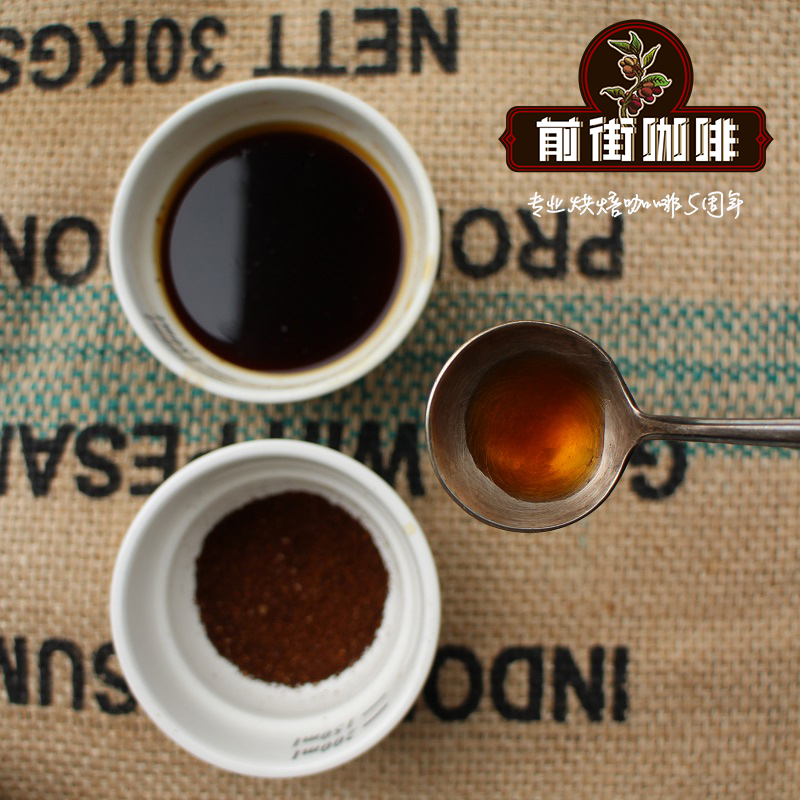
Professional coffee knowledge exchange more coffee bean information please follow the coffee workshop (Wechat official account cafe_style)
India is what kind of country, in fact, still can not put aside your imagination of the name of the open name, indeed, many people do not know the coffee beans produced in India! The treatment of Indian coffee beans also exists in general, that is, it is handled by sea breeze. Can you believe this?
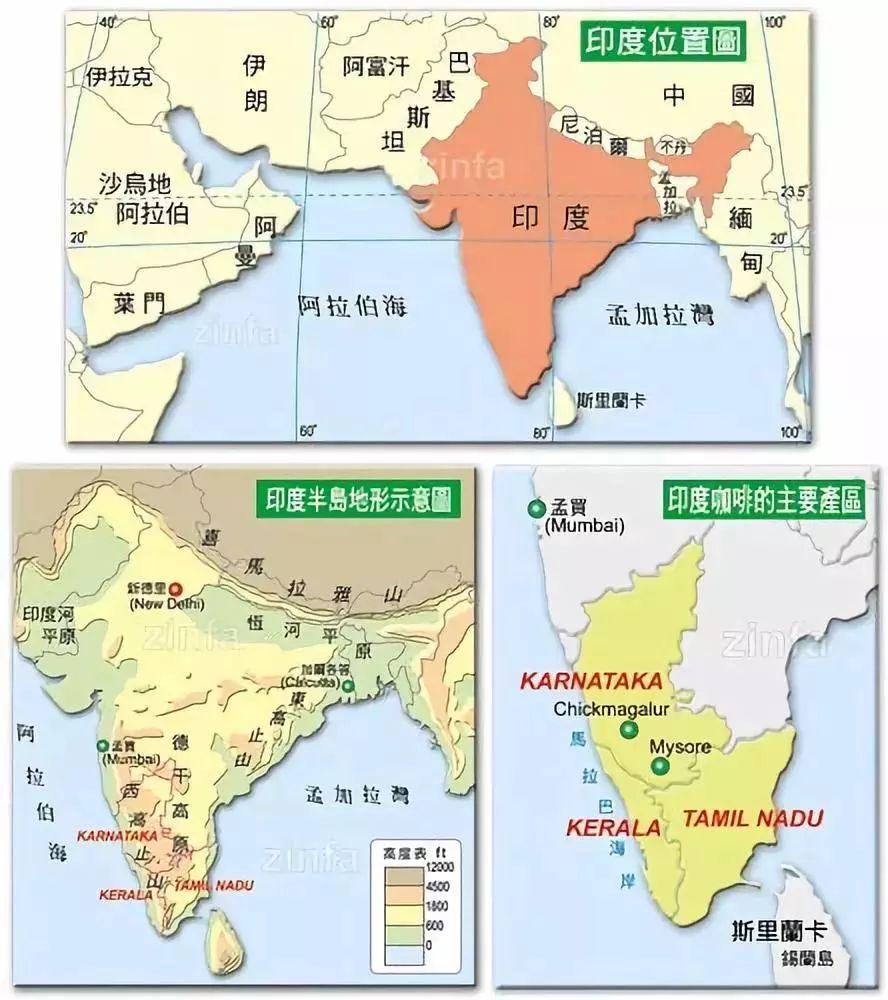
India, the first country in Asia to grow coffee
Around 1600, an Indian Islamist named Babudan made a pilgrimage to Mecca and secretly brought seven coffee seeds back to India from Moka, which was planted in the Giri Mountains of his spiritual practice in the southwestern province of Karnataka, which started the Indian cultivation industry.
How did the special flavor of Indian coffee come from?
Wind-stained coffee is an inadvertently created flavor. In the 17th and 18th centuries, merchants sailed coffee from India to Europe, which took at least half a year to travel. Raw coffee beans were placed at the bottom of the cabin, absorbing moisture and salty taste from the sea all the way. it also happens that it is soaked and dried by the sea and then soaked again.
It is conceivable that the raw beans have gone bad in Europe, the green of the coffee has completely faded and began to turn yellow, the acidity of the coffee is almost gone, and the unexpected appearance of nuts and grains tastes a bit like Xuanmi tea. Unexpectedly, Europeans fell in love with golden alternative coffee from ocean.
However, in 1869, an important historical event-the opening of the Suez Canal, shipping also moved from the sailing age to the steamboat era, and the sailing time from India to Europe was greatly shortened. May be abused by this flavor, European guests began to respond to "Indian coffee stale", and then orders plummeted, Indian exporters found it inappropriate and began to study how to solve the problem.
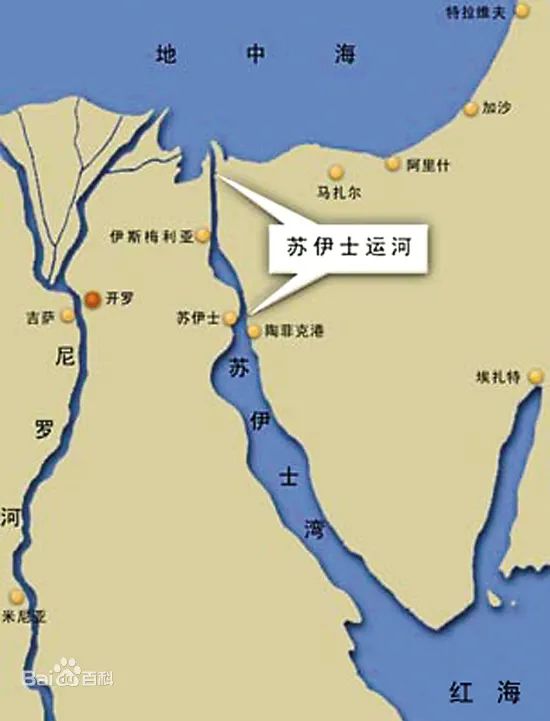
Later, it was found that the time of the coffee shipped to Europe had been shortened by more than half, so that it was too late to "change" and lose its original flavor. So the exporter thought of the salty and wet monsoon blowing from the Indian Ocean from late May to September along the coast of Malaba, India, just like the salty and wet environment in the cabin. After experiments, it produced a similar golden coffee, so it was named "monsoon coffee". Commonly known as wind-stained coffee.
Indian coffee brands are rare, and there are usually only two: wind-stained Malaba and Masojin bricks. The raw beans of the wind-stained Malaba are dry, yellow and sweet, but slightly monotonous, because they are shipped after they are placed in a ventilated warehouse to be caressed by the Indian Ocean monsoon for several seasons, so they have no sour taste, but the flavor is not enough; but Maiso is green fresh beans, rich in flavor, with wood grass aroma, mellow and low acidity, sweet taste.
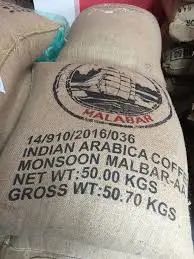
Indian Coffee-Wind stain Malabar
Wind-stained coffee is a new flavor created inadvertently. In the 17th and 18th centuries, India sailed coffee beans to Europe, which took six months. The raw beans were placed on the bottom of the barn and absorbed the moisture and salty taste of the sea. The raw beans have gone bad when they arrived in Europe. The color has changed from dark green to the yellowish brown of rice. The sour taste of coffee has almost disappeared, but it has unexpectedly developed a strong nutty and cereal flavor. It's a little bit of Xuanmi tea. Nordic people like this kind of golden alternative coffee very much.
In 1869, the opening of the Suez Canal and the advent of steamships shortened the sailing time between India and Europe, but customers began to complain that Indian coffee was "tasteless", losing the charming yellow and nutty flavor of the past, and orders plummeted. Indian exporters began to study the solution. Originally, the time of coffee shipped to Europe was more than halved, and there was no time to ripen it into a "transformation" and lose its original flavor, so exporters thought of the salty and wet environment blown by the Indian sea from late May to September every year along the coast of Malaba in southwestern India.
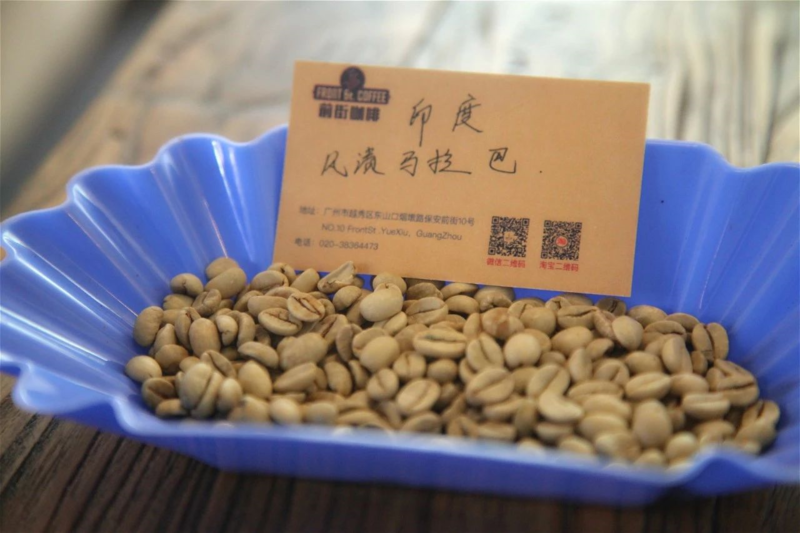
After several experiments, it has been made similar to the golden and sour coffee in the past, so it is named "monsoon coffee", commonly known as wind-stained coffee. At present, the mode of production of wind-stained beans is to first select good raw beans and transport them to the coastal wind-soaked fields, spread them out and be blown by the moist southwest monsoon, and through frequent stirring by experienced staff, the beans will be evenly exposed to the wind. this process takes four to 16 months, the coffee beans will nearly double in size, and the color will change to yellow and white, becoming a unique Indian coffee wind stain Malaba.
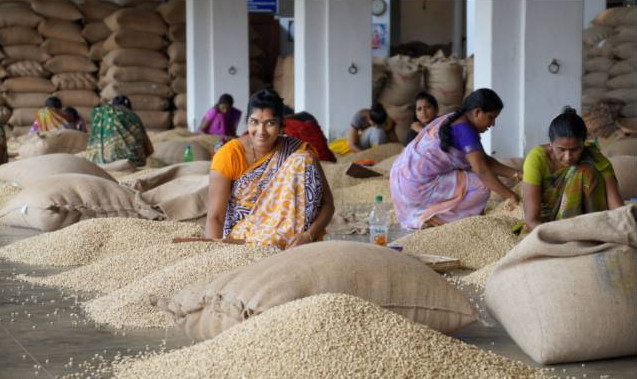
How is the wind stain treatment done?
Monsoon coffee needs to be made with sun beans. The factory where beans are stored faces to the west. The beans are laid flat in the field, and the windows are all open to catch the salty monsoon from the southwest. After reaching a certain extent, put it into the bag, but the coffee beans should not be too full, and the coffee bags should not be piled too dense so as not to be airtight and moldy, and it is time-consuming and labor-consuming to pour out coffee beans and replace sacks from time to time to avoid mold. This period of time is about 12 to 16 weeks, and after it is ripe, it will be fumigated to drive out the weevil, and finally to sift out the failed beans that have not turned golden. After at least six months to a year of monsoon blowing, the quality and quantity of beans have changed significantly. Coffee beans will swell to twice their size, reduce their weight and density, and have a moisture content of about 13%.
Name Indian Coffee Malabar
Origin / Manor Malabar Manor
The geographical environment of production is above 1000 meters above sea level
Treatment method: wind stain and sun exposure
Palate: obvious sweetness, body sticky and greasy, chocolate sweet, biscuit, fruit sweet
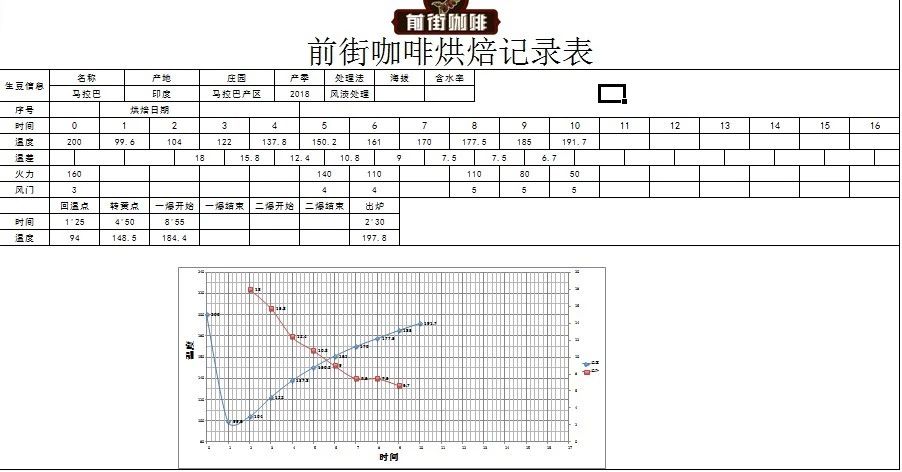
[Qianjie Coffee Baking suggestion]
This coffee belongs to the average bean density, the roasting medium firepower climbs steadily, the yellowing point is about 4 minutes and 50 seconds, then reduces the firepower and opens the throttle to enter the Mena reaction, when an explosion, open the throttle, keep the firepower, the temperature is about 184.4 ℃, 2 minutes and 30 seconds after the explosion.
Roaster: Yang family 600g semi-direct fire
The furnace temperature is preheated to 200 degrees Celsius, the throttle is opened at 3jing30s and fired, the firepower is adjusted to 160, the temperature recovery point is 1: 25 ", the firepower is maintained, 4: 50" turns yellow, the smell of grass disappears, enters the dehydration stage, the firepower is lowered to 140, the throttle is opened to 4, and the firepower is reduced to 110 again at 168 degrees.
After 8 minutes of dehydration, the bean surface appears wrinkled and black markings, and the smell of toast changes to coffee, which is a prelude to an explosion, when the firepower remains the same, the throttle opens to 5, and listen to the sound of an explosion. When it starts to explode at 8: 55 ", all the throttle doors are open." The development time after an explosion is 2 minutes and 30 seconds to 197.8 ℃.
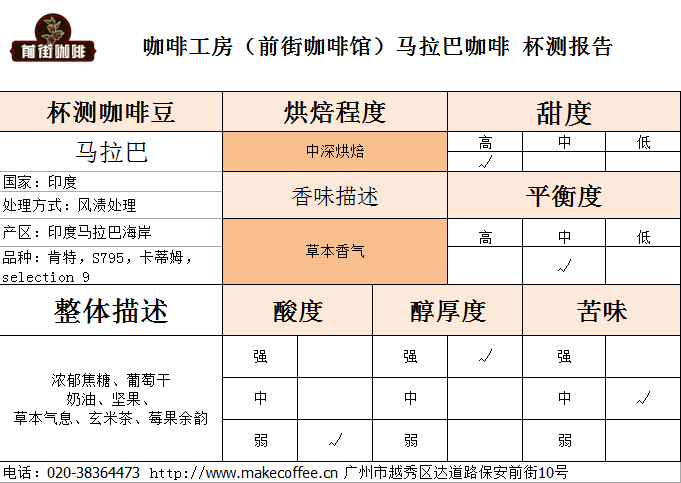
[coffee cup test report on Qianjie]
[suggestion on brewing coffee in Qianjie]
Filter cup: KONO
Water temperature: 83 °C
Gouache ratio: 1:15
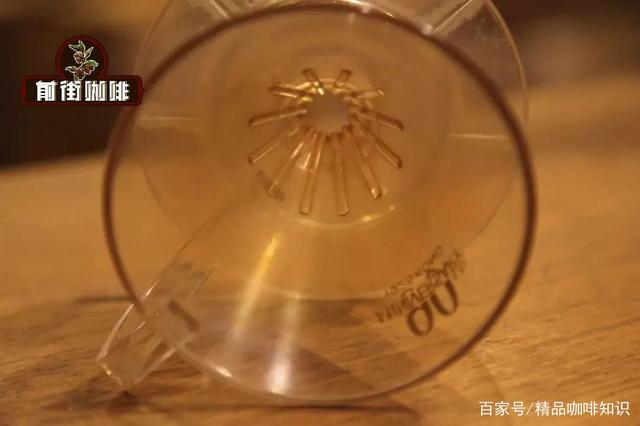
[Qianjie coffee brewing technique]
Technique: steaming with 30 grams of water for 30 seconds
Section: water injection to 125g water cut off, slightly larger water injection to 225g, extraction time 2 minutes.

[flavor description]
Rich aromas of caramel, raisins and herbs, with a raspberry finish and a taste of black rice tea.
Important Notice :
前街咖啡 FrontStreet Coffee has moved to new addredd:
FrontStreet Coffee Address: 315,Donghua East Road,GuangZhou
Tel:020 38364473
- Prev
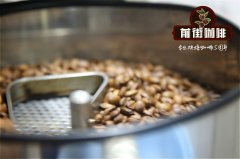
Flavor characteristics of Indian Coffee Brand Mysore Nuggets Extra Bold Masojin Coffee
Professional coffee knowledge exchange more coffee bean information Please pay attention to the coffee workshop (Wechat official account cafe_style) there are few Indian coffee brands, usually only two: wind-stained Malaba and Masojin bricks. The raw beans of the wind-stained Malaba are dry, yellow and sweet, but a bit monotonous because they are shipped after being placed in a ventilated warehouse to be caressed by the Indian Ocean monsoon for several seasons.
- Next
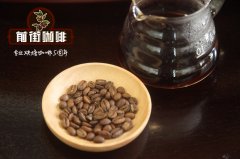
Which brand of Indian coffee is better? What are the recommendations of Arabica coffee beans in India?
Professional coffee knowledge exchange more coffee bean information please follow the coffee workshop (Wechat official account cafe_style) Indian coffee flavor introduction flavor: very little coffee from India, usually only two kinds: wind-stained Malaba and Masojin bricks. The raw beans of the wind-soaked Malaba are dry, yellow and sweet, but a little monotonous because they are placed in a ventilated warehouse for the Indian Ocean
Related
- Does Rose Summer choose Blue, Green or Red? Detailed explanation of Rose Summer Coffee plots and Classification in Panamanian Jade Manor
- What is the difference between the origin, producing area, processing plant, cooperative and manor of coffee beans?
- How fine does the espresso powder fit? how to grind the espresso?
- Sca coffee roasting degree color card coffee roasting degree 8 roasting color values what do you mean?
- The practice of lattes: how to make lattes at home
- Introduction to Indonesian Fine Coffee beans-- Java Coffee producing area of Indonesian Arabica Coffee
- How much will the flavor of light and medium roasted rose summer be expressed? What baking level is rose summer suitable for?
- Introduction to the characteristics of washing, sun-drying or wet-planing coffee commonly used in Mantenin, Indonesia
- Price characteristics of Arabica Coffee Bean Starbucks introduction to Manning Coffee Bean Taste producing area Variety Manor
- What is the authentic Yega flavor? What are the flavor characteristics of the really excellent Yejasuffi coffee beans?

